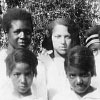
The Settlement of Oklahoma Blacks in Western Canada is a report prepared by Michael B. Payne, PhD. Dr. Payne is currently Chief Archivist, City of Edmonton Archives.
1913–1940
Several themes emerge when describing the Black experience in Alberta during the 1910s, 1920s, and 1930s including, most notably, urbanization. The isolated settlements founded by Black Americans in the first decade of the 20th century were desolate, bush-covered areas; this made farming a difficult and arduous process. However, such areas were conducive to the establishment of Black communities, with Amber Valley's being the largest and most prosperous (Amber Valley is located between the towns of thabasca and Lac la Biche in central Alberta).This being said, the isolation of these farm settlements also led to their eventual decline decades later.
 During the 1900s and 1910s,
farming in Amber Valley was
largely subsistent, just as it was in other rural Black settlements across the
province. The average amount of cropped land consisted of only 33 acres (13
hectares). Moreover, farmers faced the perennial onslaught of insects, poor
drainage, and early frosts. Self-sufficiency was crucial in order to survive.
Rural families relied on the wilderness to provide them with food and
frequently consumed rabbits, prairie chickens, moose, and fish. Access to
public health care was out of the question, so families quickly developed a
plethora of home remedies.
During the 1900s and 1910s,
farming in Amber Valley was
largely subsistent, just as it was in other rural Black settlements across the
province. The average amount of cropped land consisted of only 33 acres (13
hectares). Moreover, farmers faced the perennial onslaught of insects, poor
drainage, and early frosts. Self-sufficiency was crucial in order to survive.
Rural families relied on the wilderness to provide them with food and
frequently consumed rabbits, prairie chickens, moose, and fish. Access to
public health care was out of the question, so families quickly developed a
plethora of home remedies.
Alberta’s Black pioneers were hard working, opportunistic, and industrious. Despite their challenges and hardships, 80 percent of Alberta’s Black homesteaders remained on their land long enough to receive their homestead patents. Research has shown that Black homesteaders had a higher success rate than did other prairie homesteaders, with just over half of the other homesteaders' remaining long enough to receive their title to the land.
 Black settlers believed fostering a
sense of community was paramount to preserving and sharing their
customs and traditions. Because they lived in such a desolate and
isolated environment, maintaining social networks with other Blacks was
essential. Social gatherings with friends and family provided a congenial
atmosphere conducive to the sharing of stories, food, and laughter. In many of
Alberta’s rural Black
settlements, schools and churches were built to host such events. The
famous Amber Valley picnic, a two- or three-day celebration attracting people
within a 50-mile (80-kilometre) radius, was held in 1915. The picnic featured
plenty of food, drink, and activities, including dancing, greased pig chases,
foot races, and horse races. J.D. Edwards
started the Amber Valley Baseball
Team in 1926. The team was well known throughout northern and central
Alberta for its skill and ability; however, more importantly, members of the
team actively promoted community solidarity and pride.
Black settlers believed fostering a
sense of community was paramount to preserving and sharing their
customs and traditions. Because they lived in such a desolate and
isolated environment, maintaining social networks with other Blacks was
essential. Social gatherings with friends and family provided a congenial
atmosphere conducive to the sharing of stories, food, and laughter. In many of
Alberta’s rural Black
settlements, schools and churches were built to host such events. The
famous Amber Valley picnic, a two- or three-day celebration attracting people
within a 50-mile (80-kilometre) radius, was held in 1915. The picnic featured
plenty of food, drink, and activities, including dancing, greased pig chases,
foot races, and horse races. J.D. Edwards
started the Amber Valley Baseball
Team in 1926. The team was well known throughout northern and central
Alberta for its skill and ability; however, more importantly, members of the
team actively promoted community solidarity and pride.
 Education was
limited in Alberta’s rural settlements, with only modest one-room
schoolhouses providing a basic education. Those interested in attaining a
higher education such as a high school diploma or post-secondary education had
to move to larger towns or cities. Upon completing their education, and because
the city provided better employment opportunities for individuals with a formal
education, young adults seldom returned to their farming community.
Education was
limited in Alberta’s rural settlements, with only modest one-room
schoolhouses providing a basic education. Those interested in attaining a
higher education such as a high school diploma or post-secondary education had
to move to larger towns or cities. Upon completing their education, and because
the city provided better employment opportunities for individuals with a formal
education, young adults seldom returned to their farming community.
 In time, some Black
farmers, particularly those living in
Amber Valley, were able to move beyond the subsistent farming stage,
and they soon began raising cattle and exporting grain. The purchase of
mechanized farm equipment was another considerable step in increasing
agricultural productivity and efficiency. Amber Valley survived the Great
Depression, but the Second World War took a considerable toll on the local
population. During the 1940s, a considerable number of young men and women
moved to the city in search of better wages. Only a handful of Black families
still live in the Amber Valley
area.
In time, some Black
farmers, particularly those living in
Amber Valley, were able to move beyond the subsistent farming stage,
and they soon began raising cattle and exporting grain. The purchase of
mechanized farm equipment was another considerable step in increasing
agricultural productivity and efficiency. Amber Valley survived the Great
Depression, but the Second World War took a considerable toll on the local
population. During the 1940s, a considerable number of young men and women
moved to the city in search of better wages. Only a handful of Black families
still live in the Amber Valley
area.




